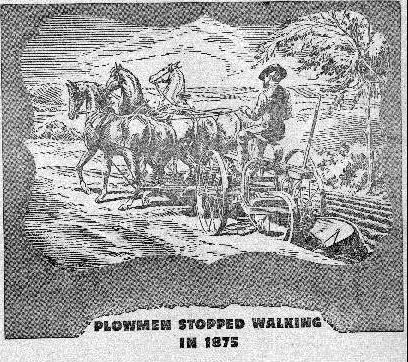
Source: Osceola Centennial Edition 1851-1951, Osceola Sentinel, August 2, 1951, Section 3, page 6.
An ad by the Paul Implement Company in the Centennial Edition shows drawings of old equipment and compares it to the new. Below are some of the drawings and their explanation of old farming methods.

Once the virgin soil of the new west was broken, weeds spread like wildfire. This necessitated check planting corn for cross-cultivation. The 2-man planter of 1853 resulted. One man drove while the other pulled a hand drop lever at rows previously laid with a sled marker. By 1878 came the Deere Rotary Drop Planter and Check Rower. It made planting a one-man job. In the 1890's planting was further improved by a planter that could count by use of seed plates.

In the summer of 1892, in the shade of a village store in northern Iowa, John Froelich built the first gasoline tractor that propelled itself forward and backward. It was known as the "Waterloo Boy" tractor. The Waterloo Gasoline Tractor Engine Company, formed by Froelich, experienced many lean years until the organiztion became a part of the John Deere company and the famous John Deere Model D was developed.

Holding a lurching plow in the ground from daylight 'til dark was gruelling work for even the brawny pioneer. No wonder the John Deere "Gilpin sulky" plow met with acclaim when it was introduced in 1875. Farmers swore by the "Gilpin Sulkies", wrote poetry about them, and bought 50,000 in the first six years.
Return to Farming